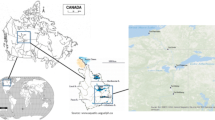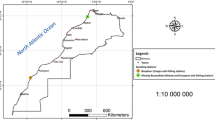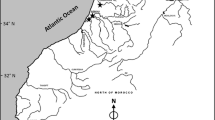Abstract
Reverse-phase high-performance liquid chromatographic analyses of bile of a territorial benthic fish, oyster toadfish (Opsanus tau), indicated that fish from reference stations in the York and Elizabeth Rivers, Virginia, contained lower concentrations of polycyclic aromatic hydrocarbon (PAH) metabolites than fish from polluted stations. PAH metabolite levels in the bile of fish from mildly polluted stations were 7 to 10 times greater than those from reference stations. PAH metabolite levels in fish from a moderately polluted station and a highly polluted station were, respectively, 20 and 50 times greater than those from reference stations. Differential patterns of five major PAH metabolites in fish from the same station suggested individual variability in metabolic pathways possibly further convoluted by the differential inductions or suppressions of hepatic mixed-function oxygenase isozyme systems under various natural or anthropogenic habitat parameters. PAH metabolite levels in the bile of oyster toadfish correlated well with the gradient of PAH contamination in the Elizabeth River sediments. High levels of biliary PAH metabolites were not detected in muskrats (Ondatra zibethicus) collected along the polluted sections of the Elizabeth River, probably due to their primarily herbivorous nature. Assuming that the hepatobiliary system and the gastrointestinal tract are the major routes of biotransformation and excretion of PAHs in the muskrats, the contaminated diet appears to be a more important routes of exposure of muskrats (and possibly oyster toadfish) to PAHs than the transdermal transfer. Occurrence permitting, we propose oyster toadfish as a useful biological sentinel for early detection of estuarine PAH pollution.
Similar content being viewed by others
Author information
Authors and Affiliations
Additional information
Received: 27 January 2001/Accepted: 1 July 2001
Rights and permissions
About this article
Cite this article
Deshpande, A., Huggett, R. & Halbrook, R. Polycyclic Aromatic Hydrocarbon Metabolites in the Bile of a Territorial Benthic Fish, Oyster Toadfish (Opsanus tau) from the Elizabeth River, Virginia. Arch. Environ. Contam. Toxicol. 42, 43–52 (2002). https://doi.org/10.1007/s002440010290
Issue Date:
DOI: https://doi.org/10.1007/s002440010290




